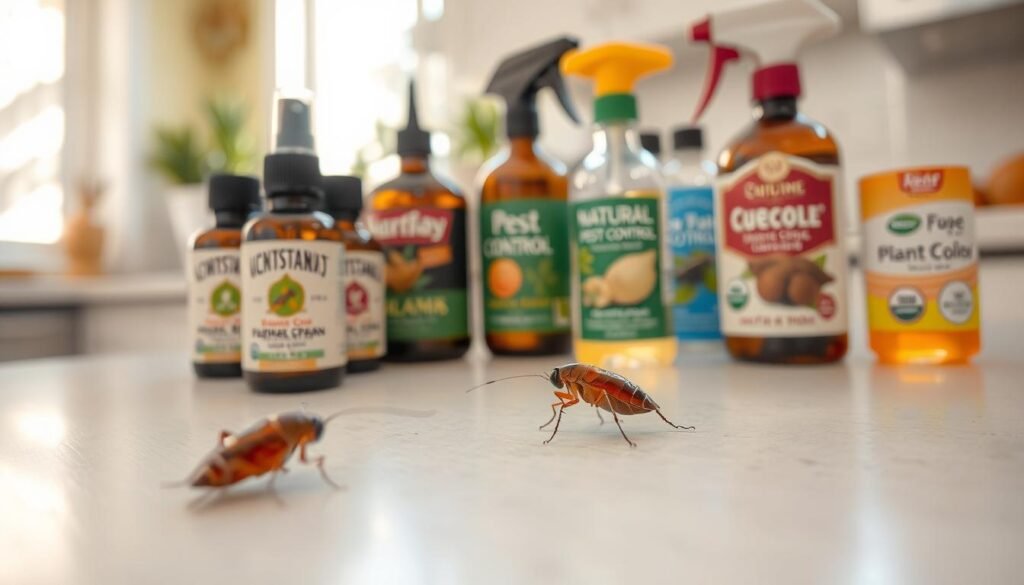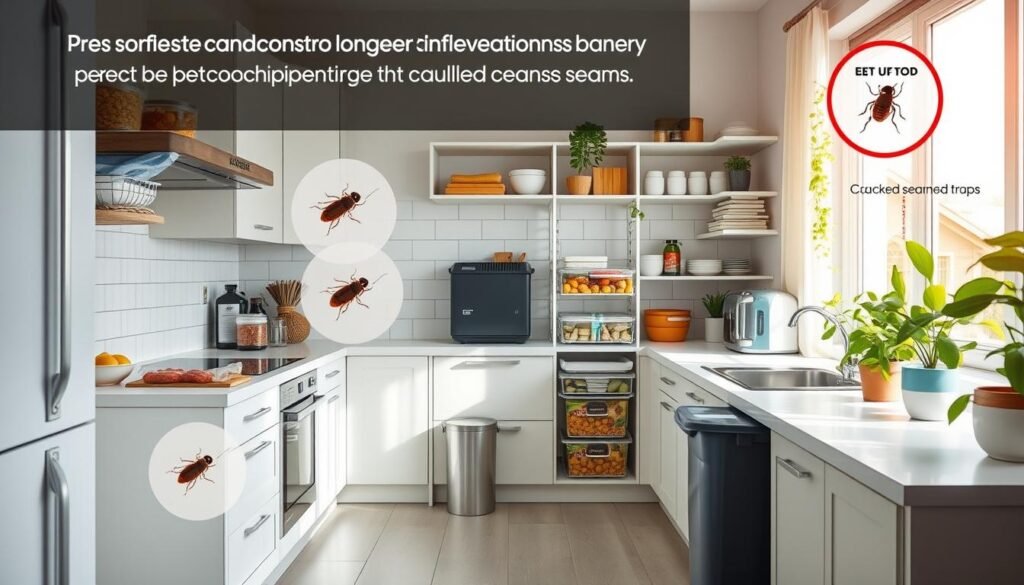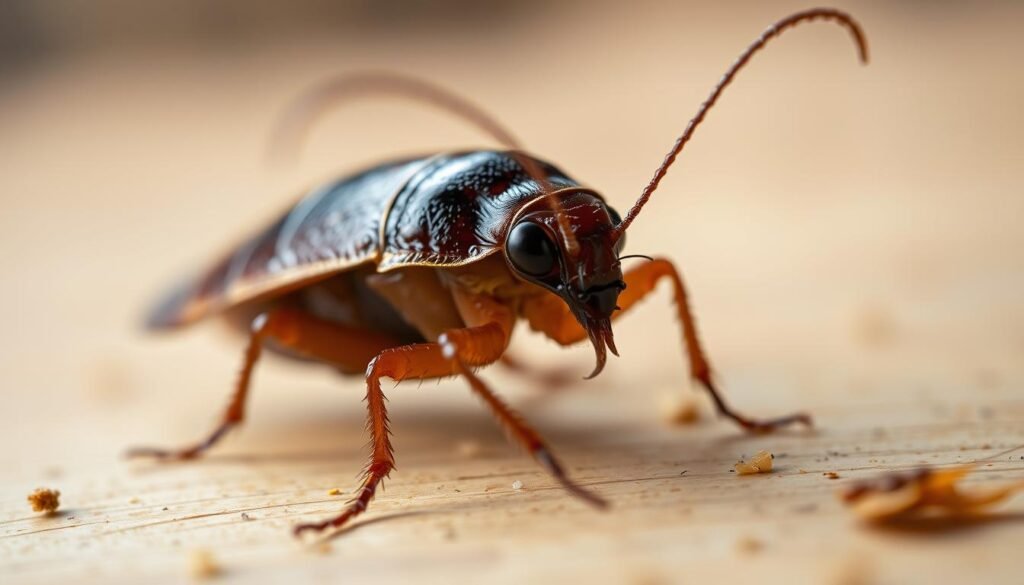Tiny roaches can wreak havoc in homes. Knowing the difference between small adult cockroaches and nymphs is crucial. German, brown-banded, and Asian cockroaches are common small species found in houses.
These pests can taint food and spread diseases. They may also trigger allergies in some people. Quick action is key to tackle small cockroach infestations effectively.
Table of Contents
ToggleKey Takeaways
- Tiny cockroaches, including German, brown-banded, and Asian species, can pose serious household problems.
- Distinguishing between adult small cockroaches and nymphs is important for effective control.
- Small cockroaches can spread diseases, contaminate food, and cause allergic reactions.
- Prompt identification and comprehensive pest control measures are essential to eliminate small cockroach infestations.
- Maintaining a clean, sealed home environment can help prevent small cockroach problems in the first place.
Understanding Tiny Cockroach Species
Small cockroach species can be a major household nuisance. The German, brown-banded, and Asian cockroaches are common indoor pests. These tiny creatures have unique traits that help with identification and control.
German Cockroaches
German cockroaches are prolific breeders. A single female can produce several egg capsules, each containing 30-40 eggs. These light-brown roaches spread diseases like Salmonella and E. coli.
They pose a significant health risk in homes and restaurants. Effective control is crucial to prevent their rapid spread.
Brown-banded Cockroaches
Brown-banded cockroaches measure about 1/2 to 5/8 inches long. They prefer warm, dry spots like bedrooms and living rooms. Their egg cases contain 10 to 18 eggs, making them persistent pests.
Asian Cockroaches
Asian cockroaches look similar to German roaches but can fly. These tan-colored pests are about 1/2 to 5/8 inches long. They’re usually found outdoors but may enter homes.
Knowing these species’ traits helps with proper identification and control. Consult a pest control expert for accurate identification and effective management strategies.
| Cockroach Species | Size | Reproduction | Habitat |
|---|---|---|---|
| German Cockroach | 1/2 to 5/8 inches | Multiple egg capsules with 30-40 eggs each | Indoors, often in kitchens and bathrooms |
| Brown-banded Cockroach | 1/2 to 5/8 inches | Egg cases with 10-18 eggs | Warm, dry environments like bedrooms and living rooms |
| Asian Cockroach | 1/2 to 5/8 inches | N/A | Primarily outdoors, but can enter homes |
Distinguishing small cockroach from Nymph
Telling apart a small adult cockroach from a nymph can be challenging. They look similar, but there are key differences to spot.
Cockroach nymphs are usually smaller than adults. German cockroach nymphs start at 1/8 inch and grow to 1/2-2/3 inches. Adult small cockroaches are bigger and move more slowly.
Color is another clue. Nymphs are often lighter, like tan or pale-brown. Adult small cockroaches are usually reddish-brown. American cockroach nymphs start under 1/4 inch and turn reddish-brown after molting.
Wings are a big difference. Nymphs don’t have fully formed wings. Adult small cockroaches do have wings, which helps identify them.
Behavior can also help tell them apart. Nymphs move quickly and erratically. Adult small cockroaches move more deliberately and controlled.
| Characteristic | Small Cockroach | Cockroach Nymph |
|---|---|---|
| Size | Larger body size | Smaller in size |
| Color | Reddish-brown | Lighter hues (tan, pale-brown) |
| Wing Development | Fully developed wings | Undeveloped wings |
| Movement | Deliberate and controlled | Erratic and scurrying |
Knowing these differences helps you spot small adult cockroaches and nymphs. This knowledge can lead to better pest control in your home.
“Identifying the right stage of a cockroach’s life cycle is crucial for implementing the most effective control strategies.”
Dangers of small cockroach Infestations
Small cockroaches can pose significant health risks and contaminate food. They carry harmful bacteria like Salmonella and E. coli, which they spread to food and surfaces. Their shed skin and feces can trigger allergies and asthma, especially in children.
Health Risks
Small cockroach infestations can lead to various health problems. They can transmit diseases like diarrhea, cholera, typhoid fever, and salmonella. You can get these diseases through direct contact or by eating contaminated food or water.
Cockroaches can also worsen allergy and asthma symptoms. Their bodies, feces, and shed skins contain allergens. These can cause chronic breathing issues and trigger reactions in sensitive people.
Food Contamination
Small cockroaches in kitchens can make food unsafe to eat. They crawl over food, utensils, and surfaces, spreading germs. This can lead to cockroach disease transmission and food poisoning.
Keep your home clean to prevent small cockroach infestations and health hazards. Quick action and effective control methods are key. These steps help keep families and communities safe and healthy.
“Cockroaches can carry and spread a variety of harmful bacteria, viruses, and parasites, posing a serious threat to public health.”
small cockroach Behavior and Habitats
Tiny cockroaches excel at finding hidden spots. They thrive in warm, humid areas and are active at night. This makes them hard to spot until their numbers grow.
German cockroaches prefer moist, warm areas like kitchens. Brown-banded cockroaches favor drier, warmer spots such as bedrooms. These small pests hide in cracks and crevices throughout homes.
| Cockroach Species | Preferred Habitats |
|---|---|
| German Cockroach | Kitchens, bathrooms |
| Brown-banded Cockroach | Bedrooms, living rooms |
| Asian Cockroach | Outdoor areas, near entry points |
Only 30 out of 4,600 cockroach species live near humans. These tough bugs have existed for over 320 million years. They’ve adapted to various environments worldwide, from tropical to temperate areas.
“Cockroaches are found in a wide range of environments, particularly in the tropics and subtropics, and can even survive in the Arctic by generating antifreeze made of glycerol to withstand temperatures as low as -122 °C.”
Smaller cockroaches, like German, Asian, and brown-banded species, are usually under 5/8 inch long. Larger types like American, Australian, brown, and smokybrown can reach 1–1/4 to 2 inches. Knowing their size and habits helps with control.
Early Detection Signs of small cockroach Presence
Spotting a small cockroach infestation early is key for effective control. These pests can hide well, but there are signs to look for. Cockroach droppings are a common indicator, appearing as small, dark pellets or smear marks.
You might find these droppings in hidden corners, under appliances, or along baseboards. Another sign is shed skins. Cockroaches leave behind translucent casings as they grow, often in their gathering spots.
A musty odor can also signal cockroach presence. This smell comes from pheromones they release. Quick action can stop a small cockroach problem from growing rapidly.
“For every one cockroach you see, there could be up to 800 more hiding nearby.”
Being alert to these signs is vital. A single cockroach egg case can hold up to 40 eggs. This can lead to fast population growth if ignored.
By staying watchful and addressing the issue early, you can effectively control small cockroach infestations. This prevents them from becoming a major problem in your home.
Effective Control Methods for small cockroach
Controlling small cockroaches requires a mix of cleanliness and targeted pest control. Proper sanitation and exclusion measures, along with insecticide baits and gels, are key. These methods address the root causes and help eliminate these persistent pests.
Sanitation and Exclusion
A clean, organized home is crucial for small cockroach control. This means removing food sources, blocking entry points, and eliminating moisture. Homeowners should take regular action to prevent infestations.
- Store food in airtight containers
- Clean up spills and crumbs promptly
- Fix any leaks or sources of standing water
- Seal cracks and crevices where cockroaches can enter
Good sanitation and exclusion make it harder for cockroaches to thrive. These measures form the first defense against small cockroach infestations.
Insecticide Baits and Gels
Cockroach baits and gels are effective tools for controlling small cockroach populations. These pest control products attract and eliminate both adult cockroaches and nymphs. When used with good cockroach management practices, they can greatly reduce infestations.
A comprehensive small cockroach control strategy can effectively eliminate these pests. This approach improves the health and safety of your living space.

Professional Pest Control Services
Professional pest control services offer the best solution for stubborn small cockroach infestations. Skilled technicians can identify species, assess problems, and create targeted treatment plans. They use powerful methods and provide ongoing maintenance to prevent future issues.
ABC Pest Control leads professional cockroach control in Dallas-Fort Worth. With 60 years of experience, they excel in residential and commercial pest control. Their certified experts deliver top-notch service for various pest problems, including small cockroach infestations.
ABC’s approach includes thorough inspections, targeted treatments, and ongoing monitoring. They use advanced methods like non-repellent pesticides and strategic bait placement. These techniques address root causes and eliminate cockroaches at all life stages.
Partnering with ABC ensures efficient handling of your cockroach problem. Their expertise, modern techniques, and customer focus make them the top choice. For premium pest control in Dallas-Fort Worth, trust ABC’s services.
| Cockroach Species | Average Size | Key Behaviors | Common Habitats |
|---|---|---|---|
| American Cockroach | 1 ½” to 2″ | Good fliers, contamination of food, disease carriers, damage to book bindings, fabrics, and wallpaper | Homes, hospitals, and warehouses |
| Brown-banded Cockroach | ½” to 5/8″ | Prefers areas over 80 degrees, found high on walls, in picture frames, behind molding, near appliance motors, light switches, closets, and furniture; scatters all over a structure | Prefers areas over 80 degrees, often found high on walls, in picture frames, behind molding, near appliance motors, in light switches, closets, and furniture |
| German Cockroach | ½” to 5/8″ | Populations increase rapidly, hides during the day, contamination of food, leaves stains, creates foul odors, carries disease | Restaurants, kitchens, stores with abundant food, moisture, and shelter |
| Oriental Cockroach | Often reaches 1″ in length | Inhabits damp locations, does not fly, increased disease vector potential | Damp locations such as crawl spaces under structures, underground water and sewage systems |
| Smokey Brown Cockroach | 1″ to 1 ¼” | Good flyers, attracted to lights at night, mobile and hard to control | Warm, dark, moist areas such as tree holes, ivies, mulch, woodpiles, attics with moisture problems. |
“ABC has over 60 years of experience providing exceptional pest control services in North Texas, with a team of certified experts and a commitment to customer satisfaction.”
Don’t let small cockroaches invade your space. Call ABC Pest Control’s professional cockroach control experts today. Enjoy peace of mind with their effective, long-lasting pest management solutions.
Preventing Future small cockroach Infestations
A cockroach-free environment needs a proactive approach. To prevent small cockroach infestations, tackle root causes. Implement effective cockroach prevention tips to keep these pests away.
Keep your home clean and clutter-free. Cockroaches love dark, damp areas and food sources. Clean regularly and store food properly. Fix any moisture issues to make your home less inviting.
- Seal any cracks, crevices, and entry points around your home to deny access to small cockroaches.
- Regularly inspect for signs of cockroach activity, such as droppings or egg cases, and take immediate action at the first signs of an infestation.
- Consider using insecticide baits and gels strategically placed in areas where cockroaches are likely to travel and nest.
- Maintain good sanitation practices, including keeping kitchen areas clean, storing food in airtight containers, and promptly disposing of trash.
If problems persist, seek help from a professional pest control provider. They can assess the situation and identify the species. Experts can create a home pest management plan to eliminate pests.
Stay proactive and keep your home clean. This will greatly reduce your chances of dealing with these unwanted visitors.

“Cockroaches are a persistent problem, but with vigilance and the right prevention strategies, you can maintain a cockroach-free environment in your home.”
Conclusion
Small cockroaches can be a big headache for homeowners. Identifying them correctly and understanding their habits is crucial. Effective control measures are key to tackling these tiny pests.
Keeping your home clean and sealing entry points can help prevent infestations. Using targeted treatments can effectively eliminate these pests. For tough cases, professional pest control services offer the best solution.
Early detection is vital to prevent rapid spread. Look out for nymphs or egg cases. Quick action can stop these resilient pests from multiplying.
A mix of prevention and control strategies can protect your family. This approach helps reclaim your space from potential health risks. It also prevents contamination associated with small cockroach infestations.
Successful small cockroach control requires a multi-pronged approach. This includes thorough cleaning, eliminating moisture, and sealing entry points. Strategic use of baits and traps is also effective.
Stay alert and address the problem early. This helps manage small cockroach populations effectively. With the right tools and expert help, you can overcome these tiny pests.
FAQ
What are the common small cockroach species that homeowners may encounter?
Common small cockroach species include German, brown-banded, and Asian cockroaches. These pests often invade homes, causing trouble for homeowners.
How can I distinguish between a small adult cockroach and a cockroach nymph (baby)?
Size, color, and wing development are key differences between adult and baby cockroaches. Nymphs are smaller, lighter in color, and lack fully developed wings.
Adult cockroaches have a larger body size and move more deliberately. Their behavior and body shape also differ from nymphs.
What are the health risks associated with small cockroach infestations?
Small cockroaches can spread harmful bacteria like Salmonella and E. coli. Their shed skin and feces may trigger allergies and asthma, especially in children.
Where do small cockroaches prefer to hide and thrive?
Small cockroaches hide in cracks, crevices, and secluded areas. They thrive in warm, humid environments and are mostly active at night.
German cockroaches prefer moist, warm areas like kitchens. Brown-banded cockroaches favor drier, warmer spots like bedrooms and living rooms.
What are the early signs of a small cockroach infestation?
Early signs include cockroach droppings, shed skins, and a musty odor. These indicators help homeowners spot problems before they worsen.
What are the effective control methods for addressing small cockroach infestations?
Effective methods include maintaining cleanliness and eliminating food and water sources. Sealing entry points and using traps, baits, and gels can also help.
For severe or persistent infestations, professional pest control services may be necessary.
When should homeowners consider seeking professional pest control services for small cockroach infestations?
Professional help is best for persistent small cockroach infestations. Experts can identify species and assess the problem’s extent.
Pest control technicians use powerful methods to implement targeted treatment plans.
How can homeowners prevent future small cockroach infestations?
Prevention requires keeping a clean, clutter-free home and eliminating food and water sources. Seal entry points and inspect regularly for signs of cockroach activity.
Take immediate action at the first signs of an infestation. This proactive approach helps prevent future problems.

